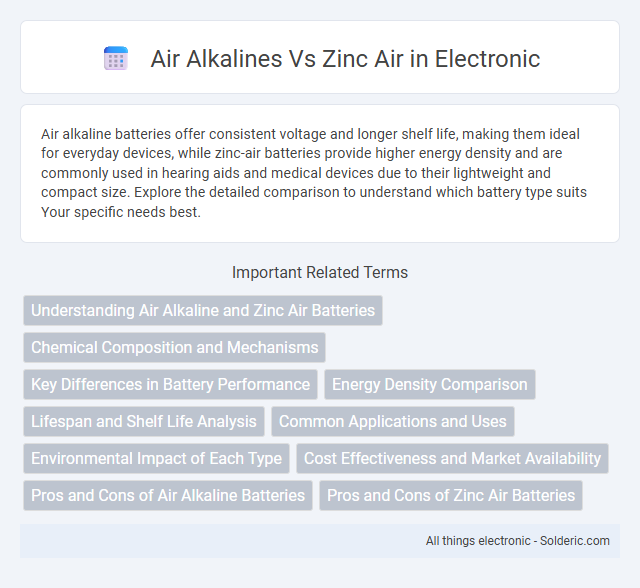Air alkaline batteries offer consistent voltage and longer shelf life, making them ideal for everyday devices, while zinc-air batteries provide higher energy density and are commonly used in hearing aids and medical devices due to their lightweight and compact size. Explore the detailed comparison to understand which battery type suits Your specific needs best.
Comparison Table
| Feature | Air Alkaline Batteries | Zinc Air Batteries |
|---|---|---|
| Chemistry | Alkaline (Zn/MnO2) | Zinc and oxygen from air |
| Energy Density | Moderate (100-150 Wh/kg) | High (270-400 Wh/kg) |
| Voltage | 1.5 V nominal | 1.4 V nominal |
| Activation | Ready to use | Activated by air exposure |
| Lifespan (Shelf Life) | 3-5 years | 2-3 years (sealed), short after activation |
| Applications | General use (toys, remote controls) | Hearing aids, medical devices |
| Disposal | Standard alkaline battery recycling | Special handling due to zinc content |
| Cost | Low to moderate | Higher price |
Understanding Air Alkaline and Zinc Air Batteries
Air alkaline batteries use a traditional alkaline chemistry with oxygen from the air acting as the cathode reactant, offering stable voltage and moderate energy density suitable for general-purpose devices. Zinc air batteries utilize ambient oxygen as the cathode reactant combined with zinc anodes, providing higher energy density and longer shelf life, making them ideal for hearing aids and medical devices. Understanding the differences in electrochemical reactions and energy output helps optimize battery selection for specific applications.
Chemical Composition and Mechanisms
Air alkaline batteries use a zinc anode and a manganese dioxide cathode with an alkaline potassium hydroxide electrolyte, relying on the redox reaction between zinc and manganese dioxide for power generation. Zinc-air batteries utilize zinc as the anode and atmospheric oxygen as the cathode, where oxygen from the air reacts with water in the electrolyte, typically a potassium hydroxide solution, causing electrochemical reactions that release energy. The fundamental difference lies in zinc-air's use of oxygen from the environment as the cathode reactant, while air alkaline batteries contain all active materials internally.
Key Differences in Battery Performance
Air alkaline batteries use a sealed design with potassium hydroxide electrolyte and offer consistent voltage output, while zinc air batteries rely on ambient oxygen, providing high energy density but limited shelf life once activated. Zinc air cells excel in applications requiring long-lasting power, such as hearing aids, due to their superior capacity, whereas air alkaline batteries perform better in high-drain devices with steady power needs. Your choice depends on whether you prioritize energy density or stable voltage performance for the intended device.
Energy Density Comparison
Zinc air batteries typically offer higher energy density compared to air alkaline batteries, making them more suitable for applications requiring longer-lasting power. The energy density of zinc air cells can reach up to 300 Wh/kg, whereas air alkaline batteries generally provide around 100-150 Wh/kg. Your choice depends on whether you prioritize compact energy storage or cost-efficiency in power delivery.
Lifespan and Shelf Life Analysis
Zinc-air batteries typically offer a longer lifespan during active use due to their high energy density and efficient oxygen reduction reaction, making them ideal for devices like hearing aids. Air alkaline batteries, while having a shorter active lifespan, boast a more stable shelf life, retaining charge longer when not in use. Your choice between these two should consider whether longer storage or extended operational time is more critical for your application.
Common Applications and Uses
Air alkaline batteries are commonly used in everyday devices like remote controls, flashlights, and clocks due to their stable voltage output and long shelf life. Zinc air batteries excel in hearing aids and medical devices, offering high energy density and lightweight design ideal for extended use. Your choice depends on device requirements such as energy demand and size constraints.
Environmental Impact of Each Type
Air alkaline batteries contain chemicals that may leach heavy metals like mercury and cadmium, contributing to soil and water pollution when improperly disposed of. Zinc-air batteries use zinc and oxygen from the air, resulting in fewer toxic byproducts and a more environmentally friendly disposal profile. The production and recycling processes of zinc-air batteries generally have a lower carbon footprint compared to traditional alkaline cells.
Cost Effectiveness and Market Availability
Air alkaline batteries generally offer higher cost-effectiveness due to lower manufacturing expenses and longer shelf life compared to zinc-air batteries. Zinc-air batteries, while providing higher energy density and stronger power output, face limited market availability primarily because of shorter lifespan once activated and sensitivity to environmental factors. The widespread commercial use of air alkaline cells ensures easier procurement and lower retail prices, making them more accessible for everyday applications.
Pros and Cons of Air Alkaline Batteries
Air alkaline batteries offer longer shelf life and stable voltage output compared to zinc-air counterparts, making them ideal for devices requiring consistent power. They are less affected by humidity and can be recharged in some cases, but their energy density is generally lower than zinc-air batteries. Your choice depends on whether you prioritize durability and rechargeability or higher energy capacity.
Pros and Cons of Zinc Air Batteries
Zinc air batteries offer high energy density and long shelf life, making them ideal for hearing aids and medical devices where compact, reliable power is essential. However, they are limited by their sensitivity to humidity and air exposure, causing shorter active use once activated and potential performance drops in extreme conditions. Your choice should balance these pros with the need for maintenance and device compatibility compared to other air alkaline options.
Air alkalines vs Zinc air Infographic

 solderic.com
solderic.com